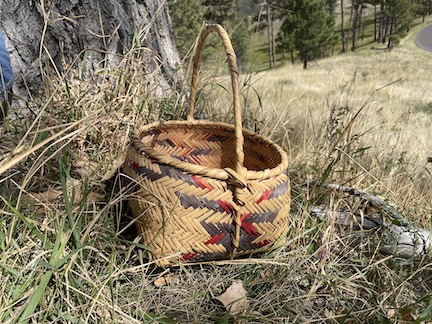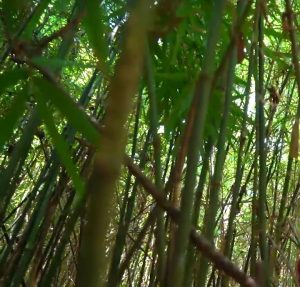 Here’s a basket I’ll show you, to explain how weaving works if you don’t have a clear image. It’s a fairly old basket that was woven by a person from the Choctaw Nation. The pattern of red and blue diamond shapes on a background of natural-colored river cane is a typical Choctaw basket design. (The blue has faded due to age.) This is an egg basket, a design that only came into existence after European colonization brought chickens to this continent. Indigenous traditions grow and change, like those of any people.
Here’s a basket I’ll show you, to explain how weaving works if you don’t have a clear image. It’s a fairly old basket that was woven by a person from the Choctaw Nation. The pattern of red and blue diamond shapes on a background of natural-colored river cane is a typical Choctaw basket design. (The blue has faded due to age.) This is an egg basket, a design that only came into existence after European colonization brought chickens to this continent. Indigenous traditions grow and change, like those of any people.
 Baskets are made of split and dried river cane, some of which is dyed red or blue and some left a natural tan color. The tribes living in Oklahoma today are helping river cane come back to the rivers there. It keeps the rivers healthy and the water clean. The river cane in this picture is growing in Oklahoma as part of the Cherokee Nation River Cane Initiative. In Indigenous worldview, even something as simple as weaving a basket connects you to the rivers, the plants, and the whole healthy ecosystem of which they — and we — are all parts.
Baskets are made of split and dried river cane, some of which is dyed red or blue and some left a natural tan color. The tribes living in Oklahoma today are helping river cane come back to the rivers there. It keeps the rivers healthy and the water clean. The river cane in this picture is growing in Oklahoma as part of the Cherokee Nation River Cane Initiative. In Indigenous worldview, even something as simple as weaving a basket connects you to the rivers, the plants, and the whole healthy ecosystem of which they — and we — are all parts.
To prepare for our work together, we should consider several things. You may explore them in any order you wish:
- Who I am, and what I’m bringing to our joint enterprise.
- What you need to bring to our joint enterprise.
- How the main section of material, “weaving the basket”, has been organized, so you know how to get the greatest possible benefit from the curriculum design.
- An “evaluation metric” that can help you monitor change in your paradigm between the beginning and end of the big weaving process.
In this short (1 minute, 15 seconds) video, I show you the basket and the way it’s put together, essentially the way it was shown to me in the second Dream. Take a look at the way the strips of river cane relate to each other so you can better understand the way the curriculum has been designed, and why. The details don’t matter. It’s the overall sense of things, the way it feels, that will help you process the things you’re about to learn and the almost unimaginable difference it can make in the way you see the natural world and your life in that world. (The video is silent until about the 30 second mark. Thank you to videographer Jo Belasco. Apologies for how windy it was the day we filmed this, and the way the wind interfered with the sound quality on the part with sound. But the wind is an integral part of Nebraska’s Pine Ridge, which is the Land that supports and empowers this work. So it’s kind of good that it’s there.)
